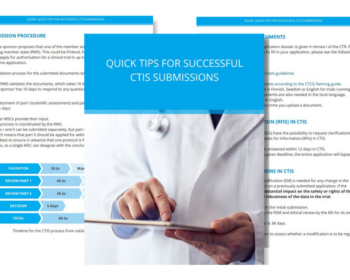
The need for technology transfers in the global pharmaceutical industry is constant. Change of drug substance or product production sites and analytical testing sites are some of the most common types of technology transfers, and analytical method transfers are a crucial part of site transfers. In an analytical method transfer, the receiving laboratory becomes qualified to perform the methods being transferred. One of the most important things in this process is the transfer of the technical and scientific knowledge of the method from the sending laboratory to the receiving laboratory. Communication between the laboratories is vital for a successful method transfer.
There are different ways to perform analytical method transfers:
Comparative
- Predetermined number of samples analysed in both receiving and sending unit
- Spiked samples can be used
Covalidation
- Method is transferred during the method validation
- Descripted in the validation protocol and reported in the validation report
Revalidation or partial revalidation
- For partial revalidation, evaluation of the parameters affected by the transfer
- Accuracy and precision typical parameters to be tested
Comparative transfer is used often and is particularly useful in cases where the method has already been validated at the transferring site or by a third party. The results can be compared between the sending and the receiving units using criteria from method validation (intermediate precision/reproducibility).
Covalidation is suitable in cases where the analytical methods are transferred from e.g. a development site to a commercial manufacturing site before the analytical methods have been validated. The receiving site can participate in reproducibility testing. Criteria are defined based on product specifications and purpose of the method.
Revalidation or partial revalidation is useful when the sending laboratory is not involved in the testing, or the original method validation has not been performed according to ICH requirements and therefore needs to be supplemented.
In some situations, however, a method transfer is not needed if it is justified and documented in the protocol.
These situations include:
Pharmacopoeia methods are used (verification of the methods)
Composition of the new product is comparable to an existing product and the receiving laboratory is familiar with the method; method linearity evaluated
Transferred method is a general method (e.g. visual, weighing, general pharmacopoeial methods)
The personnel in charge of the development, validation or routine analysis of the product at the transferring unit are moved to the receiving unit
Pharmacopoeial methods are verified if needed but do not need to be formally transferred.
In case the transfer concerns e.g. an analytical method for a new strength of a product, the transfer can be waived if the analytical methods are the same and the differences include only minor changes, such as different volumes of volumetric flasks used.
Although technical and scientific understanding of the analytical method to be transferred is a key factor to a successful method transfer, the most important thing is often good communication between the sending and receiving laboratory. Quality of communication between the sending and the receiving laboratory sites can make or break the method transfer.
Communication starts by introducing the teams to each other. Analytical experts from each laboratory should have a direct line of communication. It is also good to agree on how documentation will be shared safely and to set up regular follow-up meetings to make sure that any issues can be dealt with in a timely manner.
Introductions are followed by sharing all the relevant data and experiences of the method by the sending laboratory to the receiving laboratory. The data includes e.g. method description, validation report, quality of reference standards and reagents and information for safe handling. Any additional experience, such as risk assessment performed by the sending laboratory, is also shared. Risk analysis is based on the experience and knowledge of the sending laboratory, as well on the complexity and specifications of the method and the product. Assurance that the transferred method complies with the MA and is in compliance with the current regulatory requirements is given. This is also called gap analysis for the method validation and is a requirement in the EU1. The EU GMP guideline requires that the original validation of the test methods should be reviewed to ensure compliance with current ICH/VICH requirements. A gap analysis should be performed and documented to identify any supplementary validation that should be performed, prior to commencing the technical transfer process. If gaps are detected, supplementary validation is conducted. Receiving laboratory will evaluate this data provided by the sending laboratory.
1 Eudralex: Volume 4 EU Guidelines for Medicinal Products for Human and Veterinary Use, Part 1 Chapter 6: Quality Control, chapters 6.37-6.40
At this point, it may be smart to organise a kick-off meeting between the laboratories to further discuss the method and the need for training. If the method is complex and not familiar to the receiving laboratory, on-site training might be a good idea. All the details, including the estimated timetable, materials needed and work safety, are discussed in the meeting. It is also important to discuss the practical tips and the ‘silent’, tacit knowledge not included in the method description. Furthermore, it is important to understand the differences in local practices, e.g. how equipment is calibrated or how peaks are quantified in the HPLC or GC analysis.
After the specifics of the method transfer have been agreed, the transfer protocol is written. This is usually done by the transferring laboratory but can also be created by the receiving laboratory.
The method transfer protocol should preferably include the following:
- Objective and scope
- Each unit’s requirements and responsibilities
- Material and instruments to be used
- Analytical procedure(s)
- Additional training requirements
- Identification of any special transport and storage conditions of the test items
- Experimental design
- Acceptance criteria for each test (based on the validation study and with respect to ICH/VICH requirements)
- Time difference between the analysis of different laboratories depending on the stability of the sample
- Explanation on how any deviation from the acceptance criteria will be managed
Acceptance criteria for the transfer are usually based on reproducibility validation criteria. If validation data is not available, criteria are based on method performance and historical data. There are no definite transfer criteria that would apply to e.g. all assay tests or all related substances tests. Each transfer and method has to be evaluated on its own. Recommended data includes calculation of standard deviation, relative standard deviation and confidence interval for the results of each laboratory. In addition, the difference between mean values of each laboratory is often evaluated.
Although the criteria are dependent on the purpose of the method, the product specification and the performance of the method, some typical transfer criteria have been listed here:
| Test | Typical criteria |
| Identification | Positive (or negative) identification obtained at the receiving site |
| Assay | Absolute difference between the sites, 2-3% |
| Related substances | Requirements for absolute difference may vary depending on the level of impurities present in the sample. For low levels, more generous criteria are typically used than for impurities present e.g. above 0.5%. If some of the specified impurities are not present at levels above quantitation limit, the impurities can be spiked into the sample. In such cases, the requirement would typically be set for recovery (e.g. 80-120%). |
| Dissolution | The absolute difference in the mean value of the results – NMT 10% at the time points when less than 85% is dissolved – NMT 5% at the time points when more than 85% is dissolved |
After the transfer work, a transfer report is usually written by the receiving laboratory.
The method transfer report should include:
- Results and all the relevant data, including chromatograms and spectra
- Documentation and justifications for deviations from the protocol or method
- Conclusion as to whether the method was successfully transferred
- Acceptance criteria met: method successfully transferred
- Acceptance criteria not met: appropriate investigations and actions taken to meet the requirements until the method transfer can be regarded as successful
To sum up
Analytical methods are a crucial part of pharmaceutical manufacturing. When methods are transferred to a new laboratory, it is therefore very important to ensure that the receiving laboratory has the technical knowledge and the ability to perform the analytical method. This procedure starts by sharing all the relevant data of the method to the receiving laboratory, and usually a meeting between laboratories is held. Based on all the data and discussions, method transfer protocol is written, and the transfer is executed accordingly. Results are reported in a method transfer report, where it is concluded whether the method transfer has been successful or if extra work is needed. Thorough planning and open discussion between the laboratories involved in the method transfer are key factors for a successful analytical method transfer. They also help to prevent laboratory errors at the receiving site in the future. Carefully planned transfer criteria help to ensure that the analytical results are reliable at the new analysis site. In the case of analytical method transfers, the saying ‘Well begun is half done’ certainly applies.
Author: Pauli Laiho, Pharmaceutical Chemical Expert, Medfiles. Pauli and all our experts in our CMC expert team are happy to help in analytical projects, other CMC projects and in regulatory filing projects requiring CMC expertise.


